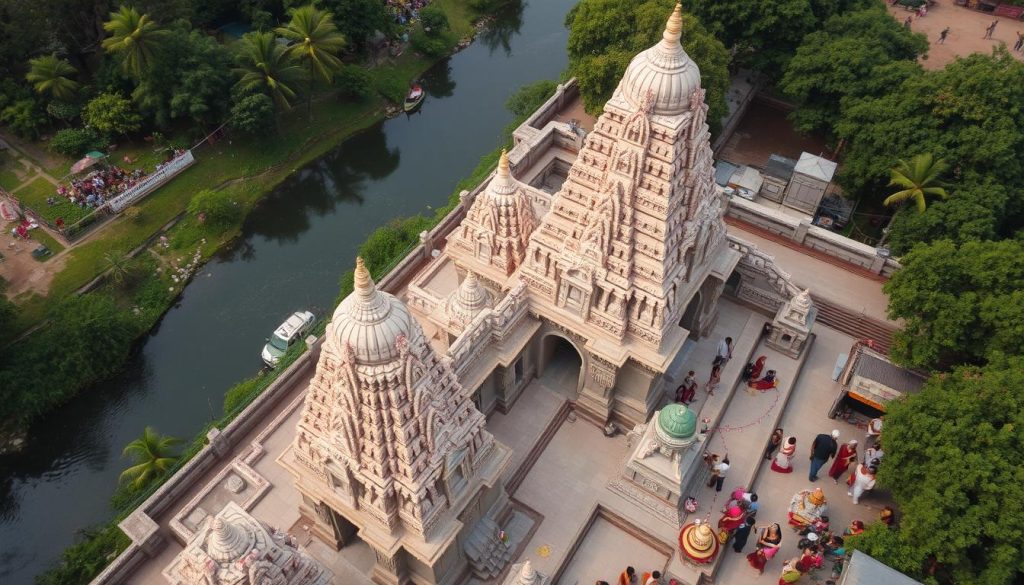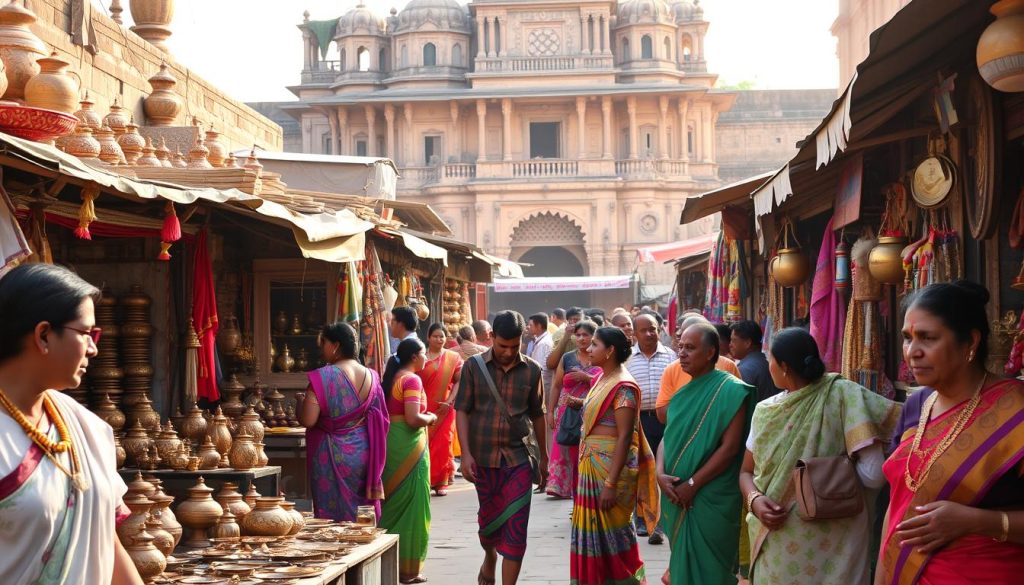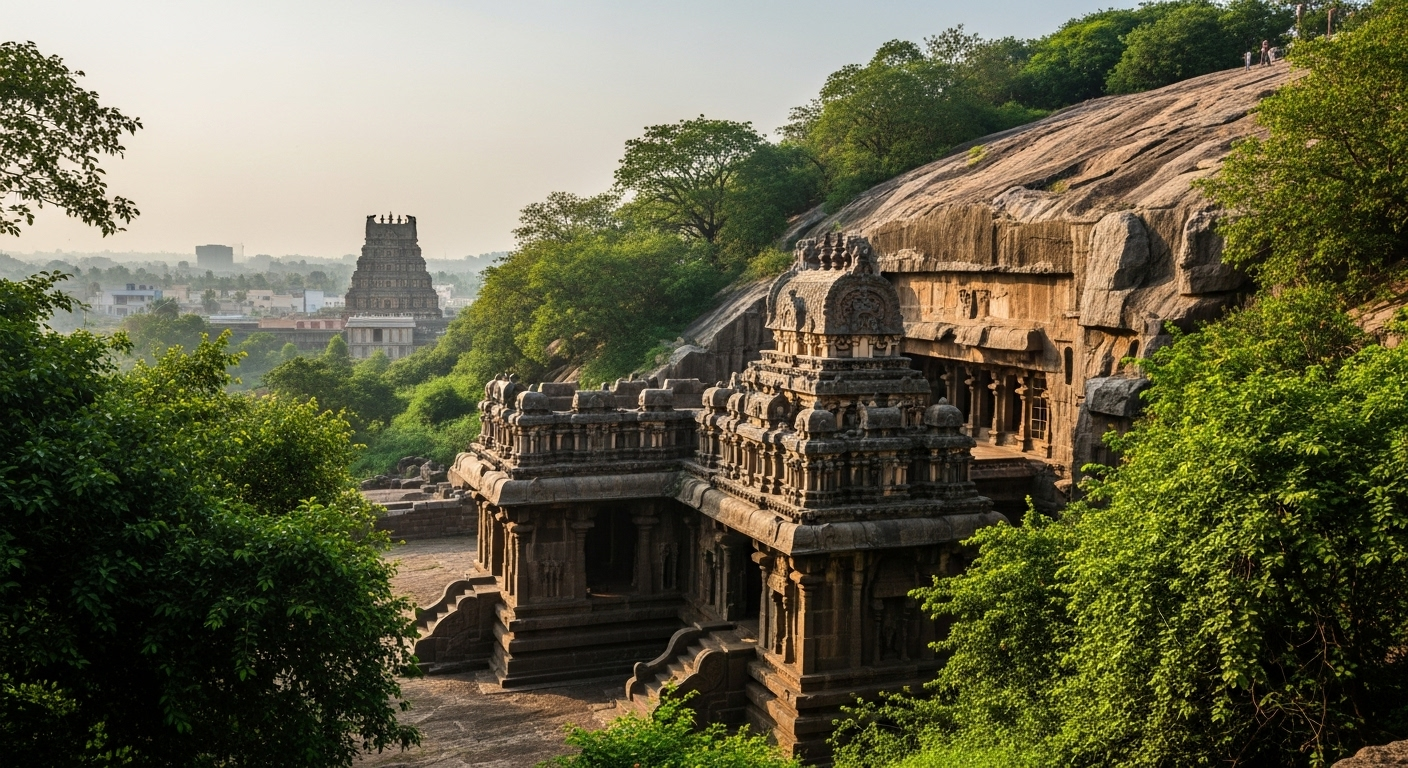In southern India, five rivers create Tiruchirappalli’s unique scenery. Stepping into the Kaveri or Kollidam River feels peaceful, where nature and history blend beautifully. Even with famous sites like the Rockfort Temple, Tiruchirappalli’s old stories are still partly hidden. They invite the curious to discover Tiruchirappalli’s past.
Known as Trichy, this city is filled with more than rivers and temples. Waterways like the Cauvery-Kollidam Sangam hold secrets of the past. Climb 437 steps at Rockfort Temple, feeling the history underfoot. Or explore the Kudamurutti River, imagining the lives it has touched.
Trichy’s tie to history isn’t just in old tales and buildings. It shines in festivals like the 78th Independence Day, bringing the city’s history to life. This place blends ancient and new, offering stories for visitors to discover. Let’s explore Trichy’s mysteries and learn about its history.
Key Takeaways
- Trichy hosts five major rivers that enhance its natural and historical allure.
- The spiritual and architectural grandeur of temples such as Sri Ranganathaswamy contribute to the city’s profound religious significance.
- Cherished for its tranquil beauty, the Cauvery-Kollidam Sangam is a bastion of peace for pilgrims and tourists alike.
- Cultural events and international cuisines add layers of vibrancy to Trichy’s rich heritage.
- A journey to Trichy is to uncover the past, indulging in the rediscovery of this ancient city’s profound narratives.
Unveiling the Ancient Roots of Tiruchirappalli
The city of Tiruchirappalli, often called Trichy, is more than a modern place. It keeps ancient secrets of Tiruchirappalli. This city in Tamil Nadu has a rich history linked with India’s heritage. It shows how Trichy has been an important center for a long time.
The Significance of Tiruchirappalli in Sangam Literature
Sangam Literature talks a lot about Tiruchirappalli. It shows the city’s old importance in Tamil kingdoms. These writings from over 2000 years ago tell us about the city’s beauty. They also give details on life back then. This makes the city vital for studying history and literature. Its role in trade, rule, and spirituality highlight its impact on Tamil culture.
Rock Fort Temple: A Glimpse Into Antiquity
The Rock Fort Temple is a key historic site in Tiruchirappalli. It sits on a huge rock and dates back to the 7th century AD. This temple shows the city’s design and religious history. It offers views of the city. This shows the mix of human work and nature’s beauty. It connects Trichy’s past and present.
History, literature, and building design come together to tell Trichy’s interesting story. Looking into its past offers more than history lessons. It helps understand how this cultural spot in South India grew.
The Role of Tiruchirappalli in Indian Independence
Tiruchirappalli, often called Trichy, is very important. It’s not just an ancient Tamil city. It also played a big part in India’s fight for independence. Its location and strategic role helped India’s struggle against British rule.
Trichy saw a lot of revolutionary actions. The city was full of freedom fighters. They held many rallies and meetings. Their strong spirit for freedom is still remembered in Tiruchirappalli historical reflections. People in Trichy were very active during the non-cooperation movement. This shows their deep love for Indian Independence.
The city has many historical sites. These places add to its old charm and story of courage. The Rock Fort is one special place. From there, you can see the whole city’s history. This history grew during the independence movements.
Trichy was very important for fighting against the British Raj. It was where leaders met and planned. The city’s role made it a key area. It helped achieve big wins in the freedom fight.
People in Trichy helped the movement a lot. They took part in protests and shared the movement’s ideas. Their bravery and teamwork were very important for Indian Independence.
Explore how the National Research Centre for Banana in Trichy remembers this brave spirit. It combines modern farming with remembering important history.
Trichy’s past and present mix in a unique way. It makes the city special. It also inspires people today. Trichy’s story of fighting for freedom is an important part of India’s history.
Hidden history of Tiruchirappalli
Tiruchirappalli, known as Trichy, is famous for more than its temples and markets. As enthusiasts explore the mysterious past of Tiruchirappalli, they find stories of hidden things. Stories about Tiruchirappalli’s secret tunnels and unknown battles show the city’s lively history.
Secret Tunnels and Forts: Legends and Reality
The tales of Trichy’s secret tunnels tell of its past. These tunnels were used during war times. They show the city’s smart design and the need for protection. Some are still hidden, but others have been found. They let us see the old defenses.
Unrecorded Battles: Tracing the Untold Stories
The unrecorded battles of Trichy are key but often overlooked. Old texts and stories hint at many fights. These battles shaped Trichy’s culture and politics. Though not widely known, they help us understand Trichy’s tough spirit and importance over time.
| Key Sites | Feature | Historical Importance |
|---|---|---|
| Kaveri River | Flowing through Trichy | Served as a defense line and a water source in times of siege |
| Kollidam River | Branch of the Kaveri | Provided strategic advantage in warfare and facilitated trade |
| Cauvery Kollidam Sangam | Confluence point | Historical meeting spot for planning and religious gatherings |
| Uyyakondan River | Scenic beauty | Offered escape routes and ambush spots in conflicts |
| Kudamurutti River | Originates from Kaveri | Used for irrigation, supporting the sustenance of local armies |
These rivers and places show Trichy’s ecological beauty. They also tell about unknown wars and defenses. Each river has a unique story. It’s linked with stories of survival and toughness in Trichy’s hidden history.
Colonial Imprints and Contributions in Tiruchirappalli
The history of Tiruchirappalli under British rule has left a big mark. This legacy can be seen in the city’s buildings and cultural mix. Local traditions and European ways came together here.
Vestiges of British Architecture
In Tiruchirappalli, British buildings remind us of the colonial era. You can see a mix of British and Indian styles in these old structures. They show how two cultures came together, using European designs with Indian materials and for the local climate.
The Influence of European Trade on Local Culture
Trade with Europe changed Tiruchirappalli in big ways. It brought new crops and goods and changed how people lived. Markets from those times were places where different groups met and shared ideas. This changed food, language, and art in the city.
Now, Tiruchirappalli is known for its history and as a cultural mix. It’s a place where the effects of British building styles and European trade can be seen. People who like history and travelers love to explore this city’s past and cultural stories.
https://www.youtube.com/watch?v=7-leTtlzxt8
Tiruchirappalli’s Historical Significance in the Development of Tamil Language
The city of Tiruchirappalli is known as a cultural and linguistic hub. It plays a key role in the growth of the Tamil language. Its history is full of scholarly and poetry work that shows its importance to Tamil linguistic heritage.
For many years, Tiruchirappalli has been important for Tamil scholars and poets. These people helped keep the language alive and growing. The city’s schools and literary places have helped nurture the Tamil language through time.
Tiruchirappalli’s role in Tamil language development is important even today. It is part of the area’s culture. The city’s location helped share ideas. This made Tamil a mix of old knowledge and new thoughts.
In its historical sites and monuments, we see how the Tamil language evolved. These places are not just old treasures. They are also important spots for the language. They show how much Tiruchirappalli has added to Tamil’s vocabulary and writing styles.
- The region’s commitment to preserving Tamil through various cultural interactions.
- Contributions of local scholars to the global understanding of Tamil.
- The impact of historical texts and inscriptions found in Tiruchirappalli on modern Tamil studies.
Research and studies in Tiruchirappalli keep showing its big role in the development of Tamil language. The work to study and renew Tamil ensures Tiruchirappalli stays important in Tamil linguistics for the future.
Learning about Tiruchirappalli’s role in the Tamil language teaches us more than just words. It shows us the culture, society, and history that shaped this ancient language. Knowing and valuing this heritage is key for anyone interested in Tamil’s literary and cultural parts.
Explore the Mysterious Past of Tiruchirappalli’s Religious Sites
Tiruchirappalli, known as Trichy, is a city full of history and spirituality. It is home to some major religious sites in Tiruchirappalli. These places attract many looking to learn about its deep past and varied faiths.
Underlying History in Temples and Rituals
Trichy is famous for its historical temples and rituals. The Rockfort Temple was built in the 7th century by the Pallavas. Climbing its 400 steps is a journey of faith. At the top, ancient inscriptions tell old stories.
The Sri Ranganathaswamy Temple is huge, covering 156 acres. It’s the largest active Hindu temple in the world. It’s known for its beautiful walls and mythological decorations.
The Jambukeshwara Temple, created by the Cholas in the 11th century, worships water. The Erumbeeswarar Temple also from that time, sits high on Marudamalai hill. It offers a beautiful view and a spiritual visit.

The Spiritual Intersection of Diverse Faiths
Trichy is known for its spiritual diversity. It has many sacred places for different beliefs. The Vekkaliamman Temple is very special. It’s devoted to Goddess Shakti. The temple is decorated with gold and silver, gifts from those of many faiths.
These places are not just for prayer. They also bring different cultures and beliefs together. This creates a unique dialogue of faith. They connect Trichy’s past and present spiritual life.
Visiting these religious sites in Tiruchirappalli is enlightening. It helps you see the city’s spiritual, historical, and cultural layers. From stunning temples to lasting rituals, Trichy plays a key role in India’s cultural and religious story.
Reviving the Lost Culinary Traditions of Tiruchirappalli
In recent years, the city of Tiruchirappalli has gained attention. It’s known for its rich culture and history. Now, there’s a big interest in its traditional foods. These traditions are more than just making food. They tell the story of the city and its past with every taste.
Local chefs and food lovers are bringing back old recipes. They share these with both locals and visitors. This way, they keep the city’s unique tastes alive. Plus, they save its food heritage from being forgotten.
There’s a big push to reintroduce these foods. Culinary workshops, food festivals, and special menus in restaurants help. They show off traditional meals and ways to cook them. Food experts work with chefs to keep dishes true to their roots. This also makes them yummy for today’s eaters.
| Dish | Ingredients | History and Significance |
|---|---|---|
| Milagu Pongal | Rice, Moong Dal, Black Pepper, Ghee | A popular temple dish, traditionally offered to Gods during festivals. |
| Karuvepillai Kozhambu | Curry leaves, Tamarind, Sesame oil, Spices | Known for its health benefits, this dish uses curry leaves as a main ingredient, showcasing the healing herbs of local flora. |
| Paruppu Urundai Kuzhambu | Chana dal, Turmeric, Hing, Tomato | This dish features lentil balls cooked in a tangy gravy; a testament to the region’s ingenuity in vegetarian cooking. |
Bringing back these traditions adds to Tiruchirappalli’s charm. It boosts tourism and unites the community. As more recipes are revived, the city shines not only as a historic place. It also becomes a must-visit for food lovers, offering a taste-filled adventure.
Revealing the Hidden History of Tiruchirappalli’s Crafts and Trades
Tiruchirappalli’s economic history is rich and woven with old traditions and crafts that survive today. Its culture and economy are shaped by Tiruchirappalli handicrafts and ancient trading practices in Trichy.

Handicrafts That Narrate a Historical Tale
Tiruchirappalli handicrafts tell stories through local artisans’ hands. Products range from jewelry, textiles, to bronzework, each with its own tale. Craftsmen use techniques passed down for generations, showing the area’s history and unique culture.
Trading Practices Lost to Modernity
Long ago, Trichy was a bustling hub for traders. Ancient trading practices in Trichy involved bartering spices, silks, and jewels. These practices enhanced exchanges among communities. Today, we see old trade ways in local markets and festivals, despite modern changes.
| Craft | Materials Used | Originating Era |
|---|---|---|
| Bronzework | Bronze, copper, tin | Sangam Period |
| Weaving | Silk, cotton | Chola Dynasty |
| Jewelry Making | Gold, silver, precious stones | Pallava Dynasty |
Reviving traditional handicrafts and trading benefits Tiruchirappalli’s heritage. It opens up local and global markets. This keeps Trichy’s crafts and trades alive, connecting past, present, and future.
Conclusion: Protecting Tiruchirappalli’s Rich Heritage for Future Generations
Tiruchirappalli’s history is rich and colorful. It has deep roots, religious importance, and cultural growth. We must care for its heritage to keep its beauty. Protecting it means preserving not just old structures and items. It’s about saving the stories and knowledge that define Trichy. This helps future generations learn and connect with the city’s past. Every monument and historic site, like the Rock Fort Temple, tells an old story. These stories teach us valuable lessons.
The city’s role in India’s independence is crucial. It is filled with tales from Sangam literature and secrets from lesser-known spots. These stories can teach and motivate both visitors and researchers. Saving physical places and bringing back ancient trades and foods is also important. This lets people live history. When traditional foods fill the streets or craftsmen create art like their ancestors, Trichy’s spirit revives. This keeps the legacy alive for us and future generations.
It’s everyone’s job to keep Tiruchirappalli’s history and culture alive. It’s not just about keeping stories in books. They should be a part of our daily lives. Safeguarding this heritage means being in constant conversation with our past and future. As today’s guardians of this legacy, we must protect historic places, educate others, and celebrate Trichy’s history. This makes sure the city’s story lives on. It won’t just be a tale from the past. Instead, it will continue to be a source of pride and learning for all.
FAQ
What is the hidden history of Tiruchirappalli?
Trichy, or Tiruchirappalli, has a rich history. Its story goes beyond its famous landmarks. It includes stories about old forts, hidden tunnels, and battles that are rarely told. These untold tales played a big part in shaping Trichy’s past.
Why is Tiruchirappalli significant in Sangam literature?
Trichy is important in Sangam literature because it’s often mentioned. These ancient Tamil texts talk about its role in early Tamil culture. They show how deep Trichy’s roots go.
What is the role of the Rock Fort Temple in Trichy’s history?
The Rock Fort Temple is key to understanding Trichy’s history. It stands on a hill and shows off the city’s religious and cultural past. It also shows how important Trichy has been through time.
How did Tiruchirappalli contribute to the Indian Independence movement?
Trichy played a big part in India’s fight for independence. There were lots of important events and actions taken here. Many heroes from Trichy helped India win freedom from British rule.
Are there any legends associated with Tiruchirappalli’s past?
Yes, Trichy is full of legends. Stories talk about secret tunnels and old forts with stories yet to be told. There are also tales of brave fighters in battles never written down. These stories make Trichy’s past very exciting.
Can you tell me about the colonial imprints in Tiruchirappalli?
Trichy has many signs from the time when the British were here. Buildings from the British era show how the city changed during that time. This mix of cultures created a unique history in Trichy.
What is the significance of Trichy in the development of the Tamil language?
Trichy has been very important for the Tamil language. It has helped Tamil literature and language grow. Trichy’s role in shaping Tamil speech and writing has been very important.
How do the religious sites in Tiruchirappalli reflect its mysterious past?
Trichy’s religious places tell stories of its hidden history. They show how different faiths meet and blend in Trichy. This makes the city’s spiritual story very rich and interesting.
What aspects of Tiruchirappalli’s lost culinary traditions are currently being revived?
People are bringing back Trichy’s old recipes and foods. They want everyone to remember and enjoy what makes Trichy’s cuisine special. This effort keeps the city’s food history alive.
How are Tiruchirappalli’s historical crafts and trades being preserved?
Trichy is keeping its old crafts and trades alive. This includes making things by hand and old ways of trading. These efforts help share Trichy’s rich history with new generations.
What is being done to protect Tiruchirappalli’s heritage for future generations?
There are efforts to save Trichy’s history. This includes fixing old buildings and teaching the youth about their heritage. People working together make sure Trichy’s culture and traditions last a long time.










